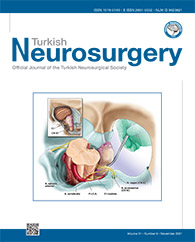2Inonu University, School of Medicine, Department of Plastic Surgery, Malatya, Turkey
3Hidir Kilinc Clinic, Plastic Surgery, Malatya, Turkey
4Inonu University, School of Medicine, Department of Neurosurgery, Malatya, Turkey DOI : 10.5137/1019-5149.JTN.32924-20.3 AIM: To evaluate fasciocutaneous flaps used for reconstruction of meningomyelocele defects in our clinic and to suggest an algorithm for flap selection.
MATERIAL and METHODS: A retrospective analysis of 45 patients with meningomyelocele, who underwent repair with fasciocutaneous flaps, was carried out. Preoperative and postoperative photos were analyzed. The defect areas were measured by Adobe Photoshop CC. Limberg flap, bilateral Limberg flaps, bilateral bipedicled advancement flaps, bilobed flap and reading man flap were performed.
RESULTS: Wound dehiscence and partial necrosis occurred in 8 patients. All wounds were managed conservatively and healed successfully. No other complications were observed. The mean defect size for all patients was 36 cm². The mean defect size was 45.3 cm² in bilateral bipedicled flaps cases; 33.5 cm² in bilateral Limberg flaps cases; and 19.6 cm² in the unilateral Limberg flap cases. According to the algorithm, a unilateral Limberg flap or bilobed flap or reading man flap can be used for the defects smaller than 25 cm²; bilateral Limberg flaps can be used for the defects between 25 and 35 cm²; and bilateral bipedicled advancement flaps can be used for the defects larger than 35 cm².
CONCLUSION: Fasciocutaneous flaps can be preferred in meningomyelocele defect reconstruction due to the easy planning of flaps, easy and fast flap elevation, and low complication rates due to their reliable circulation. The measurement of the defect area allows this algorithm selecting a flap in a more practical way.
Keywords : Meningomyelocele, Fasciocutaneous flap, Bipedicled advancement, Limberg flap, Bilobed flap




